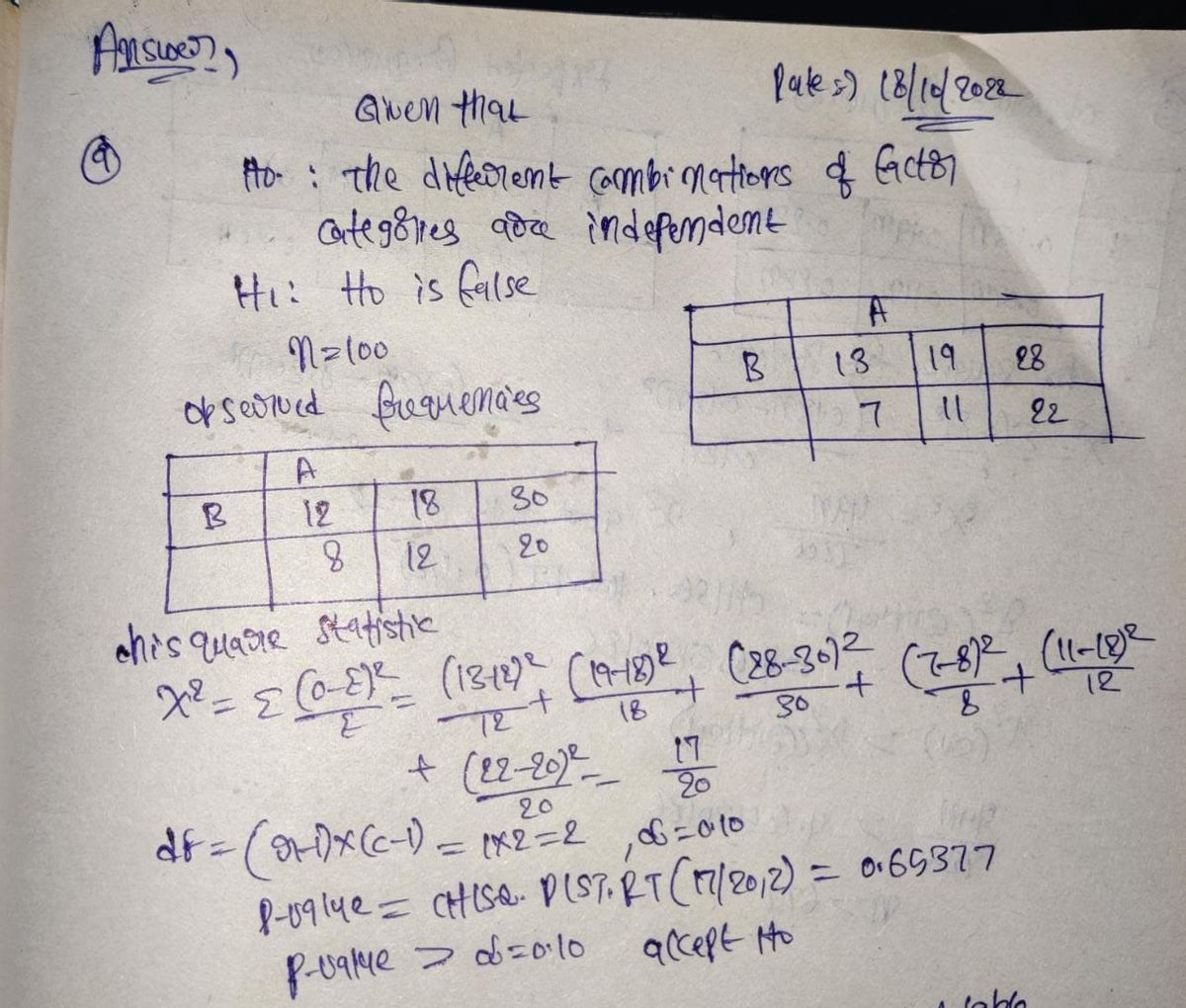Question II. The following two-by-three table gives the sample proportions corresponding to different combinations of factor categories (for example, 28% of the sample fell in the cell representing category 1 of factor A and category 3 of factor B). A B .13 .19 .28 .07 .11 .22 II(a). Suppose that the sample size is n=100. Carry out a chi-squared test of independence at the 10% significance level. Make sure to state the null and alternative hypotheses, degrees of freedom, the value of your test statistic, the p-value, and the final conclusion. II(b). Now, suppose that n=1000 and repeat part 3(a). II(c). Find the smallest value of n that will result in rejection of the null hypothesis of part 3(a) at 10% level. Start by finding the appropriate x² statistic (which will depend on the n).
Question II. The following two-by-three table gives the sample proportions corresponding to different combinations of factor categories (for example, 28% of the sample fell in the cell representing category 1 of factor A and category 3 of factor B). A B .13 .19 .28 .07 .11 .22 II(a). Suppose that the sample size is n=100. Carry out a chi-squared test of independence at the 10% significance level. Make sure to state the null and alternative hypotheses, degrees of freedom, the value of your test statistic, the p-value, and the final conclusion. II(b). Now, suppose that n=1000 and repeat part 3(a). II(c). Find the smallest value of n that will result in rejection of the null hypothesis of part 3(a) at 10% level. Start by finding the appropriate x² statistic (which will depend on the n).
MATLAB: An Introduction with Applications
6th Edition
ISBN:9781119256830
Author:Amos Gilat
Publisher:Amos Gilat
Chapter1: Starting With Matlab
Section: Chapter Questions
Problem 1P
Related questions
Question
![**Question II.**
The following two-by-three table gives the sample proportions corresponding to different combinations of factor categories (for example, 28% of the sample fell in the cell representing category 1 of factor A and category 3 of factor B).
\[
\begin{array}{c|ccc}
& \multicolumn{3}{c}{B} \\
A & 0.13 & 0.19 & 0.28 \\
& 0.07 & 0.11 & 0.22 \\
\end{array}
\]
**II(a).** Suppose that the sample size is *n*=100. Carry out a chi-squared test of independence at the 10% significance level. Make sure to state the null and alternative hypotheses, degrees of freedom, the value of your test statistic, the p-value, and the final conclusion.
**II(b).** Now, suppose that *n*=1000 and repeat part 3(a).
**II(c).** Find the smallest value of *n* that will result in rejection of the null hypothesis of part 3(a) at the 10% level. Start by finding the appropriate χ² statistic (which will depend on the *n*).](/v2/_next/image?url=https%3A%2F%2Fcontent.bartleby.com%2Fqna-images%2Fquestion%2F9c55fd55-ae67-4b97-a36c-91359ff73a6f%2Ffeb69827-36b8-4f99-9367-07964c923062%2Frpbkubm_processed.jpeg&w=3840&q=75)
Transcribed Image Text:**Question II.**
The following two-by-three table gives the sample proportions corresponding to different combinations of factor categories (for example, 28% of the sample fell in the cell representing category 1 of factor A and category 3 of factor B).
\[
\begin{array}{c|ccc}
& \multicolumn{3}{c}{B} \\
A & 0.13 & 0.19 & 0.28 \\
& 0.07 & 0.11 & 0.22 \\
\end{array}
\]
**II(a).** Suppose that the sample size is *n*=100. Carry out a chi-squared test of independence at the 10% significance level. Make sure to state the null and alternative hypotheses, degrees of freedom, the value of your test statistic, the p-value, and the final conclusion.
**II(b).** Now, suppose that *n*=1000 and repeat part 3(a).
**II(c).** Find the smallest value of *n* that will result in rejection of the null hypothesis of part 3(a) at the 10% level. Start by finding the appropriate χ² statistic (which will depend on the *n*).
Expert Solution
Step 1

Step by step
Solved in 3 steps with 3 images

Recommended textbooks for you

MATLAB: An Introduction with Applications
Statistics
ISBN:
9781119256830
Author:
Amos Gilat
Publisher:
John Wiley & Sons Inc

Probability and Statistics for Engineering and th…
Statistics
ISBN:
9781305251809
Author:
Jay L. Devore
Publisher:
Cengage Learning

Statistics for The Behavioral Sciences (MindTap C…
Statistics
ISBN:
9781305504912
Author:
Frederick J Gravetter, Larry B. Wallnau
Publisher:
Cengage Learning

MATLAB: An Introduction with Applications
Statistics
ISBN:
9781119256830
Author:
Amos Gilat
Publisher:
John Wiley & Sons Inc

Probability and Statistics for Engineering and th…
Statistics
ISBN:
9781305251809
Author:
Jay L. Devore
Publisher:
Cengage Learning

Statistics for The Behavioral Sciences (MindTap C…
Statistics
ISBN:
9781305504912
Author:
Frederick J Gravetter, Larry B. Wallnau
Publisher:
Cengage Learning

Elementary Statistics: Picturing the World (7th E…
Statistics
ISBN:
9780134683416
Author:
Ron Larson, Betsy Farber
Publisher:
PEARSON

The Basic Practice of Statistics
Statistics
ISBN:
9781319042578
Author:
David S. Moore, William I. Notz, Michael A. Fligner
Publisher:
W. H. Freeman

Introduction to the Practice of Statistics
Statistics
ISBN:
9781319013387
Author:
David S. Moore, George P. McCabe, Bruce A. Craig
Publisher:
W. H. Freeman